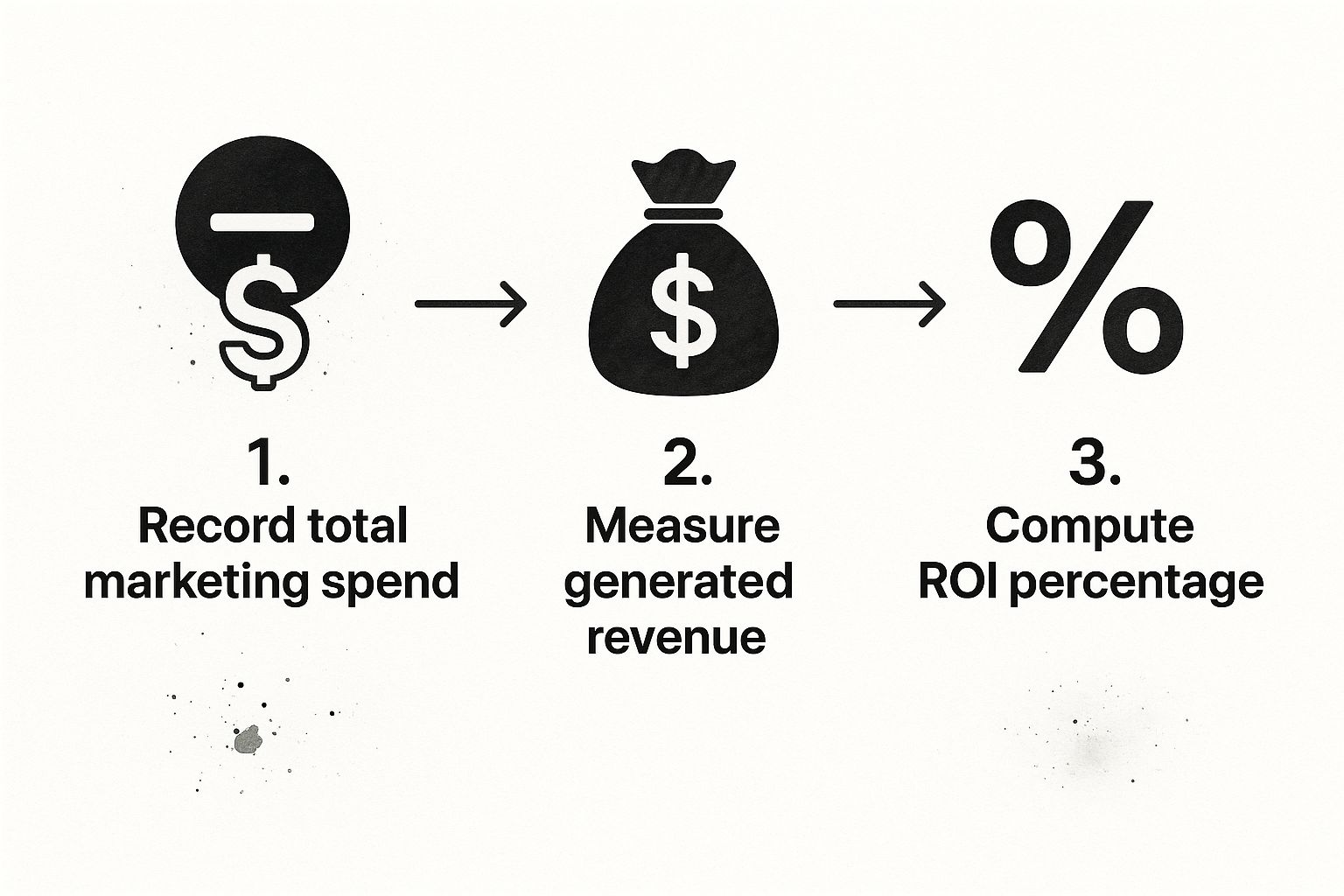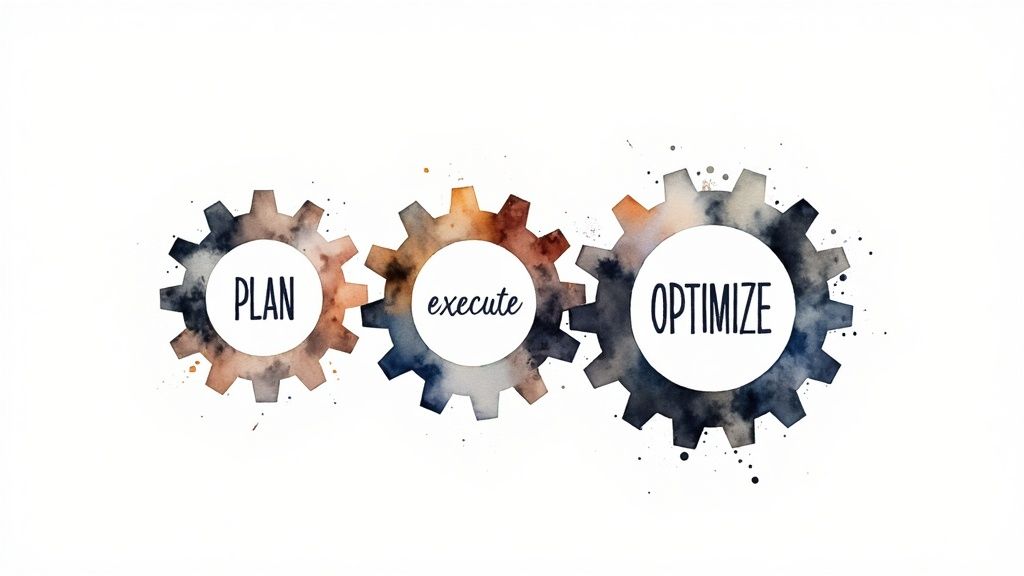Calculating marketing automation ROI isn't just an accounting exercise—it's about proving the financial horsepower of your marketing efforts. The goal is to draw a straight line from your investment to increased revenue and lower costs. It shows stakeholders that automation isn't just a line item; it's a growth engine that pays for itself.
The Real-World Value of Marketing Automation
Before we get tangled up in formulas and spreadsheets, let’s talk about what marketing automation ROI really means. It’s the tangible proof that your investment is actively making your business better, smarter, and more scalable. This goes way beyond simply scheduling emails.
When you think about it this way, the whole conversation shifts. Your automation platform stops being a "cost center" and becomes a core strategic asset. It's the silent partner working 24/7 to nurture leads, deliver personalized experiences at scale, and, most importantly, free up your team for the high-impact creative and strategic work that computers can't do.
Quantifying the Gains
The numbers tell a compelling story. Marketing automation consistently delivers a powerful return, with businesses across the board seeing major improvements in sales productivity and lead generation.
Global data shows an average return on investment (ROI) of $5.44 for every dollar spent on marketing automation. Small businesses, in particular, see a 25% increase in marketing ROI and a 14.5% boost in sales productivity directly from these tools. You can explore more data on how small businesses benefit from automation.
This financial lift comes from very real, very concrete improvements. For instance, 80% of marketers report a direct increase in leads after getting started with automation. Even better, 77% of businesses see their conversion rates climb. These aren't just feel-good metrics; they're direct inputs to your bottom line.
Beyond the Hard Numbers
While the financial return is the headline, some of the most powerful benefits are a bit harder to quantify but just as critical. Think about the consistent brand messaging you can maintain across every automated touchpoint, which builds trust and recognition over time.
Or consider the ability to react instantly to customer behavior—like sending a perfectly timed follow-up after someone visits a key page on your site. That creates a responsive, satisfying customer experience that builds loyalty.
To truly get a handle on the real-world impact, it helps to see what the pros are doing. You can dig into expert advice and unlock marketing automation ROI secrets from seasoned industry veterans. For more growth strategies, you can always check out the other guides on the https://rebelgrowth.com/blog.
When you get right down to it, a strong marketing automation ROI isn't just a number. It's a clear signal of a healthy, efficient, and growing business.
Defining Your Total Automation Investment

Before you can even think about calculating your marketing automation ROI, you need to get crystal clear on your total investment. And I’m not just talking about the monthly subscription fee you see on a pricing page.
The real number includes every single dollar spent to get your platform humming and keep it that way. If you skip this step, you’ll end up with a wildly inflated ROI that looks great on paper but doesn't reflect reality.
Your "I" in the ROI formula has to be the whole story—covering both the obvious and the not-so-obvious costs.
Hard Costs: The Obvious Expenses
These are the easy ones. The straightforward, line-item costs you’ll find on invoices and bank statements. They're simple to track, but sometimes they're scattered across different departmental budgets, so you need to hunt them all down.
- Software Licensing Fees: This is the big one, usually a monthly or annual subscription. The cost often depends on how many contacts you have or how many emails you send.
- One-Time Setup and Implementation: Did you pay a fee for initial setup, data migration, or a fancy onboarding package? Don't forget it. This cost needs to be factored in, usually spread out over the first year.
- Integration with Other Tools: Your marketing automation platform rarely works in a silo. Any costs for connecting it to your CRM, e-commerce site, or analytics tools are part of the total investment.
- Consultant or Agency Fees: If you’re paying an agency or a consultant for strategy, campaign building, or tech support, their retainer or project fees are a direct cost of your automation program.
Your total investment is the complete financial story of your automation efforts. Overlooking even one cost category—like team time—paints an incomplete and overly optimistic picture of your marketing automation ROI.
Soft Costs: The Hidden Investments
This is where a lot of businesses get it wrong. Soft costs are all about the internal resources you pour into making your marketing automation actually work. They don't show up on an external invoice, but they absolutely hit your bottom line.
By far, the biggest soft cost is your team’s time. You need to calculate the hourly cost of the employees managing the platform. Think about all the time they spend on:
- Building and testing email workflows.
- Creating content like emails, landing pages, and forms.
- Digging into campaign performance and building reports.
- Training new team members on the software.
Let's make this real. Imagine a B2B company where the marketing team spends about 20 hours per month on automation tasks. If the blended employee cost is $50/hour, that's $1,000 per month in soft costs alone.
When you add that $1,000 to your software license fee, you get a much more accurate picture of your true investment. This is the only way to get a real, honest measure of your marketing automation ROI.
Calculating Your Marketing Automation ROI
Okay, you've tallied up your total investment. Now for the fun part: figuring out the return. Calculating your marketing automation ROI is more than just plugging numbers into a formula everyone knows. It’s about digging in and assigning real dollar values to all the good stuff your platform is doing for your business.
The classic formula is a fine place to start, but it's just that—a start.
(Financial Gain - Total Investment) / Total Investment = ROI
To get a number that actually means something, you have to be meticulous about quantifying your "Financial Gain." This isn't just one number. It's a combination of new money coming in the door and real, tangible cost savings.
Measuring Direct Revenue Gains
This is where you directly connect your automation efforts to your bottom line. It's the most straightforward way to show anyone that your investment is paying off.
Start by looking at the revenue generated by specific automated campaigns. I'm talking about things like:
- Upsell and Cross-Sell Sequences: How much new revenue came from automated emails that nudged existing customers to upgrade or buy complementary products?
- Abandoned Cart Workflows: What’s the total value of sales you recovered from automated reminders sent to people who left items in their cart?
- Nurtured Lead Conversions: How much revenue can you attribute to new customers who went through an automated lead nurture sequence before they finally bought?
This is a pretty simple flow to visualize: you track your spending, measure the revenue that comes from it, and then calculate your return.

The key takeaway here is simple: you need to draw a straight line from your investment to the revenue it creates. That's the heart of any solid ROI calculation.
Accounting for Cost Savings and Efficiency
Next up, let's talk about the value of efficiency. This is what I call the "soft" return—it’s the money you saved or the productivity you clawed back because of automation. Skipping this part means you're leaving a huge chunk of your ROI story on the table. A full marketing automation ROI analysis has to include it.
To put a dollar value on these gains, think about:
- Reduced Manual Labor: How many hours did your team spend on repetitive tasks before automation? Think sending follow-up emails, segmenting lists, or manually updating CRM records. Multiply those hours by their hourly wage. That’s a real saving.
- Increased Sales Productivity: Because of lead scoring and automated nurturing, your sales team isn't wasting time on cold or unqualified leads. Estimate the value of that reclaimed time, which they can now spend closing high-value deals.
The proof is in the pudding. The data shows that 76% of companies using marketing automation see a positive return within the first year. It’s also been shown to boost sales productivity by a solid 12.2%. On top of that, 80% of marketers report an increase in leads, and 77% see higher conversion rates. You can dig into more marketing automation statistics to get the full picture.
Putting It All Together: A Scenario
Let's walk through a quick example. Imagine a SaaS company spends $20,000 over one year on its automation platform, including software, training, and content creation.
In that same year, they track the results and can directly attribute:
- $40,000 in revenue from automated upsell campaigns.
- $15,000 in recovered revenue from abandoned trial sign-up flows.
- $10,000 in saved labor costs from automating lead qualification and follow-up.
So, the total financial gain comes out to $65,000.
Plugging that into our formula: ($65,000 - $20,000) / $20,000 = 2.25.
That translates to a 225% ROI. Now that is a powerful number you can confidently take to your boss or the board.
Practical Strategies to Boost Your Automation ROI

Getting a positive return from your marketing automation is a solid start. But let's be honest, "good" isn't the goal. We want exceptional.
To get there, you have to ditch the old "set it and forget it" mindset. True growth in your marketing automation ROI comes from constantly tweaking, testing, and optimizing based on real data.
A great place to start is with a smart lead scoring model. This system gives points to leads based on who they are (job title, company size) and what they do (visit your pricing page, download a guide). This simple move helps your sales team zero in on the hottest, most sales-ready prospects, so they're not wasting time on conversations that go nowhere.
Segment and Personalize at Scale
The days of one-size-fits-all email blasts are long gone. If you're serious about boosting your marketing automation ROI, you need to get granular with audience segmentation.
This means grouping your contacts into smaller, hyper-focused lists. You can segment them based on their interests, what they've bought before, or where they are in your sales funnel. Once you have these segments, you can hit them with personalized content that actually speaks to them. A new lead might get a welcome series, while a loyal customer could get an exclusive offer.
This kind of personalization isn't just a nice-to-have anymore; it's a core driver of your return. It turns your automation from a simple messaging tool into a powerful engine for building relationships, nurturing leads, and boosting customer lifetime value.
This demand for smarter targeting is pushing the whole industry forward. The marketing automation market is on track to hit $15.62 billion by 2030, and 91% of decision-makers say requests for automation are climbing. AI is a huge part of this, powering around 77% of personalized content creation and making this level of targeting easier than ever.
Continuously Test and Refine Your Workflows
Your automated workflows aren't carved in stone. To really squeeze the most out of them, you have to be testing and refining all the time. This is where A/B testing becomes your best friend.
Focus on testing the little things that make a big difference in your email sequences:
- Subject Lines: Try out different tones, lengths, or adding a personal touch.
- Call-to-Action (CTA): Experiment with button colors, text, or where you place it.
- Email Content: Pit a plain-text email against a fancy, designed one.
- Timing and Cadence: Does sending emails in the morning beat the afternoon? Test it.
Even tiny bumps in open or click-through rates can stack up and have a massive impact on your overall marketing automation ROI. To really dial things in, you'll want to follow some proven marketing automation best practices.
Finally, a rock-solid, seamless sync between your automation platform and your CRM is non-negotiable. This creates a single source of truth about your customers, letting both marketing and sales work from the same playbook. Marketing sees which leads actually close, and sales gets the full story on a lead's journey before they even pick up the phone. This connection breaks down data silos, pumps up lead quality, and directly fuels a higher return on your investment. Pair this with high-converting landing pages, and you'll really start to see the results amplify.
How to Report Your ROI to Stakeholders
Figuring out your marketing automation ROI is a massive win. But that’s only half the job. If you can't show that value to your leadership team, you’re going to struggle to keep your budget, get buy-in for new ideas, and maintain momentum.
Your numbers need a story. Dropping a spreadsheet in an email and calling it a day just won't work. You have to weave a narrative that ties your automation efforts directly to what the C-suite actually cares about: revenue, market share, and making the business run smoother.
Create a Visual ROI Dashboard
The best way to demonstrate progress is to make it impossible to miss. A clean, visual dashboard is your best friend for tracking key performance indicators (KPIs) over time. This isn't about cramming every single metric onto one screen.
You want to zero in on a handful of high-impact numbers that tell the whole story in a single glance. Think of your dashboard as the one source of truth for automation performance, making it simple to see what's working and celebrate the wins as they happen.
Make sure to include the essentials:
- Customer Acquisition Cost (CAC): Show how automation is making it cheaper to bring in new customers.
- Lead-to-Customer Conversion Rate: This one’s a classic for a reason. It highlights how many leads are actually becoming paying customers.
- Revenue from Automated Campaigns: Directly connect sales to specific workflows, like abandoned cart sequences or upsell emails.
- Sales Team Efficiency: Track things like the number of marketing-qualified leads (MQLs) you're passing over. This proves you're helping sales focus on closing, not prospecting.
This approach turns reporting from a stale, one-off document into an active conversation about how marketing is driving growth.
Build a Compelling Narrative
Data gives you the proof, but a solid story is what makes it stick. When you present your marketing automation ROI, frame your results in a story of progress and tangible impact. Don't just state, "our lead conversion rate went up by 15%."
Instead, tell them what that actually means for the business.
“By launching a new lead nurturing workflow, we boosted our lead conversion rate by 15% in Q3. That directly added $50,000 to the sales pipeline and, just as importantly, let our sales reps focus on closing deals instead of chasing down cold leads.”
See the difference? This connects your specific action to a clear, bottom-line result that every single person in the room can grasp. It also frames the marketing team as a profit driver, not just another department with expenses. If you want to see how other high-growth marketing teams operate, check out how these companies build their strategies.
Use a Quarterly ROI Report Template
For consistency and clarity, it pays to use a standardized report structure. A quarterly ROI report is the perfect cadence to summarize performance, call out major wins, and lay out your game plan for the next three months.
Your report needs to be quick to scan and highly visual. Lean on charts and graphs to show trends and keep the walls of text to a minimum. A solid template should always include:
- Executive Summary: Just one paragraph. Hit the quarter's biggest wins and the headline ROI number.
- KPI Performance vs. Goals: A dashboard-style view comparing your actual results to the targets you set at the beginning of the quarter.
- Key Campaign Highlights: Pick one or two campaigns that really knocked it out of the park. Briefly explain the strategy, the results, and what you learned.
- Challenges and Learnings: Be upfront about what didn't go as planned and, more importantly, how you're adapting your approach.
- Next Quarter's Focus: Briefly outline your top priorities for the upcoming quarter to keep everyone aligned and excited.
Common Questions About Marketing Automation ROI

Even with a perfect roadmap, you're bound to have some questions about marketing automation ROI. It's totally natural. You're putting a lot of time, energy, and money on the line, so a few lingering uncertainties are expected.
Think of this section as a quick-and-dirty FAQ where we tackle the questions we hear all the time. Our goal is to give you direct, practical answers so you can sidestep common roadblocks and feel confident in your strategy.
How Long Until I See a Positive ROI?
This is the big one, and the only honest answer is: it depends. The timeline for seeing a positive marketing automation ROI really hinges on your industry, the typical length of your sales cycle, and just how complex your setup is.
But you don't have to wait forever to see a payoff. In fact, most businesses get there much sooner than they think.
Data shows that a whopping 76% of companies using marketing automation see a positive return on their investment within the first year.
Your first taste of ROI will likely come from quick efficiency wins—like all the hours your team gets back from not having to send manual emails. The more substantial, revenue-based returns usually start building up over 6 to 18 months as your nurtured leads finally mature into paying customers. It's key to set this realistic timeline when you're talking to stakeholders.
What Are the Biggest Mistakes That Hurt ROI?
While automation is a powerful ally, it’s not a magic wand. There are a few all-too-common missteps that can absolutely torpedo your potential return. The good news? They're all completely avoidable once you know what to watch out for.
The biggest blunders almost always come down to poor strategy and messy data. These are the pitfalls we see most often:
- Buying the Tool First: Jumping into a software subscription without a clear plan for how you'll actually use it is a classic recipe for frustration and wasted cash.
- Ignoring Data Quality: If your CRM is a mess or your database is full of junk, your personalization efforts are dead on arrival. You'll just end up sending generic, ineffective campaigns.
- Setting and Forgetting: The most successful teams treat their workflows like living, breathing things. They're constantly A/B testing and tweaking them based on real performance data.
- Tunnel Vision on Email: Focusing only on email campaigns means you're leaving money on the table. You're ignoring some of the best features, like lead scoring, dynamic website content, or even SMS follow-ups.
Steering clear of these traps is one of the most direct ways you can protect and maximize your marketing automation ROI.
Can I Calculate ROI Without Direct Attribution?
Yes, you absolutely can. While being able to trace a sale directly back to one specific campaign is the gold standard, it's just not realistic for most complex customer journeys. Don't let the perfect be the enemy of the good here.
You can still build a very strong ROI case by tracking "influenced revenue." This just means measuring how many of your eventual customers were touched by your automation efforts at some point along their journey.
And beyond that, you can prove the value with other super compelling metrics: * Cost Savings: Put a number on the value of reduced manual labor and the hours your team can now spend on higher-value tasks. * Sales Team Efficiency: Show an uptick in the number of calls made or demos booked because your lead scoring is serving up better prospects. * Improved Conversion Rates: Highlight a higher lead-to-opportunity conversion rate. This proves you're not just sending more leads to sales, but better ones.
Taking this more holistic view gives you a complete and much more persuasive picture of your marketing automation ROI, even when that direct line from touchpoint to sale gets a little blurry.
Ready to stop guessing and start growing? rebelgrowth gives you the AI-powered tools and insights to not just measure your marketing ROI, but to amplify it. From AI-generated blog content to a powerful backlink exchange and a marketing agent that automates your growth strategy, we have everything you need to succeed. Take control of your marketing at https://rebelgrowth.com.
